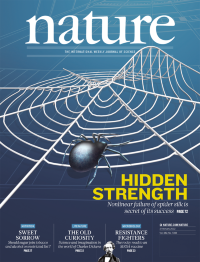Volume 482
-
No. 7386 23 February 2012
The English mathematician Alan Turing was born on 23 June 1912 and died tragically aged only 41, yet his influence is still felt in many fields. In this issue marking the centenary of Turings birth, Nature hails him as one of the top scientific minds of all time (see pages 440 and 441). Computer specialists and those working in fields that have exploited computer science including Sydney Brenner (page 461) and Henry Markram (page 456) explain some aspects of this remarkable legacy. For more, go to www.nature.com/turing.
-
No. 7385 16 February 2012
The channelrhodopsins are light-gated ion channels, found in algae, that have rapidly become familiar in the neuroscience lab as optogenetics reagents: the activities of neurons expressing channelrhodopsins can be optically controlled within systems as complicated as living mammals. The X-ray crystal structure of a chimaera of two channelrhodopsins has now been determined at 2.3 E resolution. The structure reveals the molecular architecture of this ion channel, including the retinal-binding pocket and cation conduction pathway. This work paves the way for the design of new channelrhodopsin variants with enhanced properties. Cover image: Hiroshi M. Sasaki.
Insight
-
No. 7384 9 February 2012
Hundreds of extrasolar planets have been found since the first confirmed discoveries in the mid-1990s. Many of them are large hot Jupiters�, but steady improvements in observational capabilities have brought us closer to detecting smaller Earth-sized bodies, and now, the planet-hunting space observatory Kepler has discovered two in orbit around the Sun-like star Kepler-20. Planet Kepler-20 f has a radius almost identical to that of Earth, and Kepler-20 e is slightly smaller, at 0.87 times Earths radius. The radii of the planets and the architecture of the system � at least three larger planets orbit the host star � suggest that the Earth-sized planets are rocky, and that the outer planet (Kepler-20 f) may have developed a thick atmosphere of water vapour.
-
No. 7383 2 February 2012
Spider silk is one of natures super-materials. Its remarkable mechanical properties include high extensibility and strength comparable to that of steel. But Markus Buehler and colleagues show that it is not just these virtues that make silk ideal for web construction. Silks nonlinear stress response linear at low strain, suddenly softening as strain increases then stiffening prior to failure is also critical. This behaviour allows webs to keep their shape when experiencing small, distributed loads such as those exerted by wind. But during strong local deformations, such as those caused by falling debris, the geometrical arrangement of the threads and the nonlinear stress response combine to limit damage to the area near the impact site, so that the web remains functional. Credit: S. Cranford, M. J. Buehler/MIT. Dickens (inset): Rex Features.




